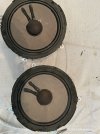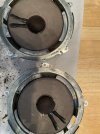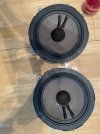unix-guy
Master of RTFM
Just throwing this out there since we have a broad user base with a wide range of knowledge.
I have a 2007 Toyota Sequoia with a factory premium JBL speaker system and power amp.
The speakers have a known problem where the speakers deteriorate causing buzzing/rattling/distortion.
In addition, the speakers are non-standard: there's a tweeter mounted on the upper part of the front door window frame and inside the front door is a 7" woofer and a small (2" I think) midrange driver, both mounted in a special bracket.
Factory replacements run $350+ per door... And there are also kits you can buy to repair the speakers but they seem a bit fiddly and I didn't feel like messing with that.
So I bought aftermarket coaxial 6.5" speakers with replacement mounting brackets and a replacement speaker wiring harness from Sonic Electronix.
All of this is part of a "set" designed for this purpose.
Got everything disassembled, reassembled and mounted in the door.
Go to connect the factory speaker connector to the wiring harness... No go!
Then I noticed that the factory connector has 4 wires: 2 for the woofer and 2 for the mid driver... But the replacement speaker only needs 2 wires as it's a coaxial design with a built-in crossover.
More research and it appears the factory amp (maybe) sends independent signals with different frequencies to the woofer and mid driver.
Found a post where someone suggested connecting both positive signals to the speaker positive and both grounds to the speaker ground.
I did a lot of searching for wiring adapters and all the ones that are supposed to be for my car are only 2 pins and 2 wires...
I did find a couple others that might also be supported by not a lot of detail. For those, they do actually appear to combine the signals as described above.
Since I'm comfortable with soldering wires, I could actually do this on my own by cannibalizing the wiring harnesses from the original speakers.
So, that's a long wind up to ask if that seems like it's safe?
Or if anyone has any first hand experience with reworking these Toyota + JBL systems.
Also, the original speakers (woofer / mid driver) are each 3ohm. The new coaxial is 4ohm total.
I have a 2007 Toyota Sequoia with a factory premium JBL speaker system and power amp.
The speakers have a known problem where the speakers deteriorate causing buzzing/rattling/distortion.
In addition, the speakers are non-standard: there's a tweeter mounted on the upper part of the front door window frame and inside the front door is a 7" woofer and a small (2" I think) midrange driver, both mounted in a special bracket.
Factory replacements run $350+ per door... And there are also kits you can buy to repair the speakers but they seem a bit fiddly and I didn't feel like messing with that.
So I bought aftermarket coaxial 6.5" speakers with replacement mounting brackets and a replacement speaker wiring harness from Sonic Electronix.
All of this is part of a "set" designed for this purpose.
Got everything disassembled, reassembled and mounted in the door.
Go to connect the factory speaker connector to the wiring harness... No go!
Then I noticed that the factory connector has 4 wires: 2 for the woofer and 2 for the mid driver... But the replacement speaker only needs 2 wires as it's a coaxial design with a built-in crossover.
More research and it appears the factory amp (maybe) sends independent signals with different frequencies to the woofer and mid driver.
Found a post where someone suggested connecting both positive signals to the speaker positive and both grounds to the speaker ground.
I did a lot of searching for wiring adapters and all the ones that are supposed to be for my car are only 2 pins and 2 wires...
I did find a couple others that might also be supported by not a lot of detail. For those, they do actually appear to combine the signals as described above.
Since I'm comfortable with soldering wires, I could actually do this on my own by cannibalizing the wiring harnesses from the original speakers.
So, that's a long wind up to ask if that seems like it's safe?
Or if anyone has any first hand experience with reworking these Toyota + JBL systems.
Also, the original speakers (woofer / mid driver) are each 3ohm. The new coaxial is 4ohm total.



